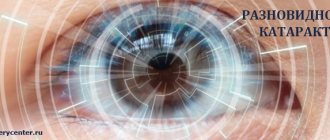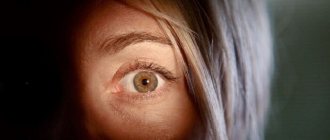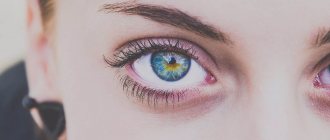An international group of scientists, with the participation of Russian specialists, has identified a gene in which mutations explain hereditary blindness. We are talking about the causes of Leber's hereditary optic neuropathy, a rare disease that leads to complete loss of vision. Until recently, the genetic causes of its occurrence in 24% of cases remained not entirely clear. Scientists have found that visual impairment can develop due to a mutation in the DNAJC30 gene. Research has shown that there are more carriers of this mutant gene among Russian residents than in other countries. But knowing the causes will make it possible to more accurately diagnose the disease, and in the future create a cure for it.
Classification of diseases of the organs of vision
Diseases of the visual organs are extensive, so for convenience they are divided into several large sections.
According to the generally accepted classification, all pathologies of the visual organs (including diseases of the visual organs in children) are divided into the following groups:
- optic nerve pathologies;
- diseases of the lacrimal ducts, eyelids, orbits;
- glaucoma;
- diseases of the conjunctiva;
- pathologies of the eye muscles;
- diseases of the iris, sclera, cornea;
- blindness;
- lens diseases;
- pathologies of the vitreous body and eyeball;
- diseases of the choroid and retina.
In addition, a distinction is made between hereditary and acquired diseases of the organ of vision.
What can happen before the baby is born?
During the period of intrauterine development, processes can occur in the child’s visual apparatus that will cause congenital, or antenatal, eye pathology. This concept hides various disorders in the structure and function of the eyes, as well as their accessory (auxiliary) apparatus, caused by their improper formation.
As a rule, changes in the baby’s genes lead to the appearance of such defects. They can be inherited from their parents, but more often they arise as a result of exposure of the expectant mother’s body to teratogenic (that is, capable of causing mutations) factors, which include:
- some infections (for example, rubella, toxoplasmosis and cytomegalovirus);
- alcohol;
- smoking;
- certain medicines.
Depending on what stage of intrauterine development the mutation occurred, an anomaly in the structure of one or more components of the visual apparatus is formed.
The most common pathology that develops is ptosis (drooping) of the upper eyelid. It leads to a decrease in visual acuity and a slight narrowing of its fields, as it does not allow the retina to fully function.
Visual impairment is also accompanied by a congenital change in the size of the eyeball (microphthalmos), which often occurs against the background of a syndromic genetic pathology, but can also appear in isolated form if contact with a mutagen occurs in the second to sixth week of the baby’s intrauterine development.
Approximately in the third or fourth week of development, the main eye lens is formed - the lens, congenital pathologies of which are always accompanied by a decrease in visual acuity and can lead to strabismus. Common defects include:
- underdevelopment or complete absence of the lens (aphakia);
- change in its shape - lenticonus;
- reduction in size – microphakia.
They can be combined with displacement of the lens, that is, its ectopia, which can provoke an increase in intraocular pressure and the development of secondary glaucoma. Glaucoma, in turn, can lead to the death of retinal and optic nerve cells. The optic nerve is the most important part of the eye apparatus, responsible for transmitting impulses to the brain. It is formed from the third to tenth week of fetal development. Mutations can lead to underdevelopment and complete absence of nerve fibers, as well as the formation of colobomas in their area. Severe changes in the optic nerve are accompanied by complete blindness.
Anomalies in the development of the choroid, which are detected in approximately every twentieth child suffering from eye pathology, can also lead to permanent blindness. Often they are manifested by the absence of one or more of its fragments, that is, the presence of colobomas.
Congenital colobomas of the eye appear at one of the early stages of intrauterine development of the fetus due to a disruption in the process of closing the so-called embryonic fissure. They often affect several structures of the visual apparatus (retina, iris and the choroid itself), and severely disrupt their functions. From 3 to 11% of childhood blindness in the world is due to this pathology. There are often cases when colobomas are combined with disruption of the child’s nervous and musculoskeletal system.
The listed developmental anomalies can be accompanied by various defects in the structure of the retina - a thin layer of cells capable of receiving and transmitting light impulses to the brain. These defects often cause vision loss in childhood.
Causes of eye diseases
The main causes of eye diseases are:
1. Various infectious agents (Staphylococcus aureus, gonococcus, pneumococcus, Haemophilus influenzae and Pseudomonas aeruginosa). In addition, inflammatory diseases of the organs of vision can be caused by parasites, fungi, viruses (herpes, molluscum contagiosum, adenovirus, chlamydia, cytomegalovirus, aspergillosis, toxoplasma and a number of others). If left untreated, these diseases can cause a number of complications.
2. Defects and anomalies of development (cause hereditary diseases of the organ of vision).
3. Age-related degenerative-dystrophic changes (glaucoma, cataracts).
4. Tumor and autoimmune processes.
5. Pathologies of other organs that affect the condition of the visual organs (hypertension, dental diseases, meningitis, encephalitis, diabetes mellitus, anemia, leukemia, and so on).
Symptoms of eye diseases
Eye diseases can have different symptoms.
Myopia (myopia). With this vision defect, the image is projected not on the retina, but in front of it. As a result, a person sees close objects well and poorly those that are far away. Most often, myopia develops in adolescents. If corrective measures are not taken in time, the disease will progress, which can lead to severe vision loss and disability.
Farsightedness. With this vision defect, the image is formed behind the retina. When a person is young, he can achieve a clearer image of close objects by straining his vision. One of the symptoms of farsightedness is frequent headaches.
Conjunctivitis. This is an inflammation of the conjunctiva. The main symptoms are photophobia, lacrimation, pain and pain in the eyes, discharge from the eyes.
Strabismus. The main symptom is the asymmetrical arrangement of the corneas in relation to the edges and corners of the eyelids. Strabismus can be either congenital or acquired.
Computer syndrome. Characterized by double vision, pain, dryness, and increased sensitivity to light.
Glaucoma. A pathology in which there is a periodic increase in eye pressure. As a result, optic nerve atrophy may develop and visual acuity may decrease.
Cataract. It is characterized by clouding of the lens and can only be treated surgically.
Trembling of the eye (nystagmus). Manifested by spontaneous trembling of the eyeballs.
Treatment
In case of anophthalmia, prosthetics of the eye cavity is necessarily performed, which allows for proper growth and development of the child’s facial skull, prevents the appearance of pronounced defects in his appearance, and provides a good cosmetic effect.
Ocular cavity prosthetics prevents abnormal growth and development of the child’s skull
As the child grows, the size of his skull also increases. This necessitates repeated surgical interventions, which involve removing the old prosthetic eyeball and replacing it with a new, larger one. That is why, at present, most ophthalmologists in the treatment of anophthalmia in children prefer to adhere to a non-surgical technique: after local anesthesia, a hyaluronic acid preparation is injected into the depths of the child’s orbit.
Injection treatment of anophthalmia can begin from the first days of a person’s life. The therapy is performed on an outpatient basis and does not cause discomfort to patients. At the same time, the necessary conditions are provided for the proper growth and development of the tissues surrounding the orbit, and the development of facial asymmetry is prevented. After the growth period is completed, a traditional prosthesis is installed.
Diagnosis of eye diseases
The main methods of examining the organs of vision are:
1. Autorefkeratometry. Used to diagnose astigmatism, hypermetropia, myopia.
2. Biomicroscopy. Using this technique, it is possible to diagnose cataracts, glaucoma, various neoplasms in the early stages, and identify foreign bodies (even the smallest ones).
3. Gonioscopy. Used to diagnose glaucoma. Based on this study, the ophthalmologist decides which method of treatment for glaucoma is necessary in this particular case, conservative or surgical.
4. Visiometry. Testing visual acuity known to every person using special tables and a set of lenses.
5. Perimetry. Used to identify early detection of sensitivity disorders of the pathways, optic nerve, and retina.
6. Tonometry. Measuring intraocular pressure. Its increase is the main symptom of glaucoma, a dangerous disease that, if not treated promptly, can cause blindness.
7. Ophthalmoscopy. Fundus examination.
8. Ultrasound of the eye orbits. It is carried out to identify pathologies of the optic nerve, lens, choroid, vitreous body, and so on.
9. Laboratory research. They are carried out for infectious diseases of the organs of vision to identify the pathogen and prescribe adequate treatment.
Treatment
Treatment for a congestive disc depends on the cause.
First of all, it is necessary to eliminate space-occupying formations in the skull - tumors, edema, hematomas.
Typically, corticosteroids (prednisolone) and the introduction of hyperosmotic agents (glucose solution, calcium chloride, magnesium sulfate), diuretics (diacarb, hypothiazide, triampur, furosemide) are used to eliminate edema. They reduce extravasal pressure and restore normal perfusion. To improve microcirculation, Cavinton and nicotinic acid are administered intravenously, Mexidol (IM and into the retrobulbar space - an injection in the eye), and a nootropic drug - Fezam - is prescribed orally. If stagnation occurs against the background of hypertension, then treatment is aimed at treating the underlying disease (hypertensive therapy).
Sometimes intracranial pressure can only be reduced by cerebrospinal puncture.
The consequences of stagnation require improvement of tissue trophism - vitamins and energy supplements:
- a nicotinic acid;
- B vitamins (B2, B6, B12);
- aloe extract or vitreous in injection form;
- riboxin;
- ATP.
Treatment of eye diseases
The level of development of medicine in our time makes it possible to diagnose diseases of the organs of hearing and vision in the early stages.
As a result, doctors have the opportunity to carry out preventive measures to prevent the progression of the disease or carry out effective treatment using conservative, physiotherapeutic and surgical techniques.
Depending on the type of eye pathology, its causes and severity, selection of contact lenses and glasses, surgery, laser correction, and so on may be prescribed.
It is important to note that almost any eye disease in children can be successfully cured if parents pay attention to its symptoms in time and take the child to the doctor.
Congenital cataract
Another common eye pathology in children is congenital cataracts. This pathology accounts for about 60% of all congenital eye pathologies, as well as 10% of all cases of cataracts. 5 out of 100 thousand children need treatment for congenital cataracts.
The etiology of congenital cataracts can be different: in some cases the disease is hereditary, in other cases it is caused by disorders of intrauterine development. Metabolic disorders are often the cause of congenital cataracts. In addition, this pathology can lead to:
- hypothyroidism;
- hypocalcemia;
- viral infections;
- toxoplasmosis;
- diabetes.
Early diagnosis and early surgical treatment of cataracts with implantation of an artificial lens can minimize the likelihood of severe consequences, especially in the first six months of a baby’s life. Further treatment methods are selected by the doctor on an individual basis: if necessary, pleoptoorthoptic treatment, vision correction with glasses and contact lenses are performed.
Exercise therapy for diseases of the visual organs
The possibilities of exercise therapy in ophthalmology have not yet been fully explored. Of all eye diseases, exercise therapy is actively prescribed in our country only for glaucoma and myopia.
However, for glaucoma, massage is more often prescribed, and physical therapy is prescribed according to the same scheme as for hypertension. For myopia, exercise therapy is prescribed much more often and its high effectiveness has been clinically proven.
Physical therapy is useful for all myopic people (except for patients who also have retinal detachment). Age in this case does not matter much, but it is known that exercise therapy for children with diseases of the visual organs is most effective.
The earlier exercise therapy is prescribed and the lower the degree of myopia, the better the treatment result will be. For congenital myopia, exercise therapy does not have much effect.
The main objectives of physical therapy in the treatment of myopia are:
- general strengthening of the body;
- strengthening the sclera and eye muscles;
- improving the functioning of the cardiovascular system and respiratory system;
- improving blood supply and nutrition of eye tissue.










